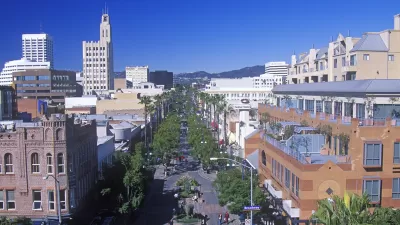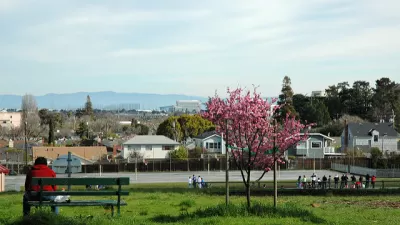The city of Santa Monica increased in population by 6,500 between 1960 and 2010, while the rest of Los Angeles County grew by 60 percent over the same period. A debate over a new downtown plan that includes more housing was never going to be simple.

Christopher Hawthorne, architecture critic for the Los Angeles Times, provides coverage of the city of Santa Monica's ongoing Downtown Community Plan process, and the "gulf" between two entrenched camps regarding the politics of growth, housing, and development.
On one side there's "the slow-growth or even no-growth faction," and on the other there's the "pro-growth and pro-housing advocates." Hawthorne cites Santa Monica City Manager Rick Cole to describe how the political debate in the desirable coastal city played out in the defeat of slow growth measure LV on the November 2016 citywide ballot and in the debate leading up to the DCP's final steps. "The philosophical differences between the two camps have been thrown into sharp relief," writes Hawthorne.
But according to Cole, something surprising happened as the DCP wound its way through the approval process, first at the planning commission and then in front of the full city council. Santa Monica, he argues, managed to build a bridge across the yawning growth gap.
Hawthorne also gives Cole a chance to speak on some of the progressive land use regulation practices included in the proposed plan, including, for example, the elimination of parking minimums and approvals for three big projects already in the pipeline. Hawthorne also provides his critiques of the plan, including its decision to lower the height limits along the northern edge of downtown and its reliance on a 30 percent affordable housing requirements, which some pro-development advocates say "will give developers an incentive to steer clear of housing altogether in downtown Santa Monica."
In the end, however, Hawthorne writes this column as a critique of Cole's pitch for a "grand bargain," or a balanced approach to the construction of new housing.
It was surprising, then, to see an article by Jason Islas for Santa Monica Next, published the day before the city council's vote on the DCP, citing an email from Cole asking the council to "assess how 1000-1500 new units of market rate and affordable units being constructed in our Downtown in the next couple of years (unaffected by the DCP) will be viewed by the various community stakeholders." Islas is obviously skeptical about the plan's ability to live up to its billing as a grand bargain: "The Downtown Community Plan, based on Cole’s email, seems to be a recapitulation of the policies that have turned Santa Monica into a city increasingly inaccessible to only wealthy people or the few lower-income people who get into the scarce affordable units that get built each year."
The debate over housing and growth, for now, is over, as the city approved the plan, according to a Tweet sent by Rick Cole last night.
Downtown Community Plan unanimously approved by City Council.@santamonicacity@DTSantaMonica@StreetsblogLA@HawthorneLAT@CurbedLA pic.twitter.com/UxzF1cPiB4
— Rick Cole (@SaMoCole) July 26, 2017
FULL STORY: Santa Monica's 'grand bargain' on growth and housing: A model for other cities?

Alabama: Trump Terminates Settlements for Black Communities Harmed By Raw Sewage
Trump deemed the landmark civil rights agreement “illegal DEI and environmental justice policy.”

Planetizen Federal Action Tracker
A weekly monitor of how Trump’s orders and actions are impacting planners and planning in America.

The 120 Year Old Tiny Home Villages That Sheltered San Francisco’s Earthquake Refugees
More than a century ago, San Francisco mobilized to house thousands of residents displaced by the 1906 earthquake. Could their strategy offer a model for the present?

In Both Crashes and Crime, Public Transportation is Far Safer than Driving
Contrary to popular assumptions, public transportation has far lower crash and crime rates than automobile travel. For safer communities, improve and encourage transit travel.

Report: Zoning Reforms Should Complement Nashville’s Ambitious Transit Plan
Without reform, restrictive zoning codes will limit the impact of the city’s planned transit expansion and could exclude some of the residents who depend on transit the most.

Judge Orders Release of Frozen IRA, IIJA Funding
The decision is a victory for environmental groups who charged that freezing funds for critical infrastructure and disaster response programs caused “real and irreparable harm” to communities.
Urban Design for Planners 1: Software Tools
This six-course series explores essential urban design concepts using open source software and equips planners with the tools they need to participate fully in the urban design process.
Planning for Universal Design
Learn the tools for implementing Universal Design in planning regulations.
Clanton & Associates, Inc.
Jessamine County Fiscal Court
Institute for Housing and Urban Development Studies (IHS)
City of Grandview
Harvard GSD Executive Education
Toledo-Lucas County Plan Commissions
Salt Lake City
NYU Wagner Graduate School of Public Service





























